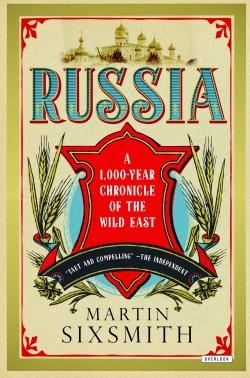Russia
A 1000-Year Chronicle of the Wild East
Given the well-documented deeds of Lenin, Trotsky, Stalin, Khrushchev, Brezhnev, Yeltsin, Gorbachev, and Putin, a casual geo-political history buff might get the mistaken idea that the brutal, seventy-year Communist experiment in autocratic rule was a Soviet-era invention. But the Soviet approach—centralized power, the Bolshevik/Communist party’s complete emasculation of other political parties in parliament (so that they retained sole authority to make appointments to powerful posts in both party and government), and impotent local governments around the vast country—was just another flavor of an inheritance from tsarist times, when corrupt forms of personal patronage owned the day. At the close of the twentieth century, the country was on a nearly five-hundred-year run, with only spasmodic episodes of political enlightenment along the lines of European-style democracies.
Taken in its entirety, this fantastic book by former BBC Moscow correspondent Martin Sixsmith points to a nature vs. nurture conundrum: Are the Russian people uniquely predisposed to brutal autocratic rule? Why did so many Russian rulers take hesitant steps toward political reform only to revert back? Do the country’s endless borders present such a psychological burden as to leave its people in perpetual fear of invasion?
In five sections and forty-one short, accessible chapters, Sixsmith exemplifies good storytelling. He writes with the cadence and comfort of a professional talker, and all of Russian history seems to earn his complete interest. Even so, the years of Stalin’s reign form the heart of his book.
Following Lenin’s death in 1924, Stalin was not in a favorable position to assume the top leadership position and needed all of his political gifts and a fair amount of luck to seize and then consolidate power. Sixsmith says Stalin made it “his business to know the blemishes on everyone’s [primarily Trotsky’s] record, and he used them to blacken his opponents.” Indeed, he could play rougher than anyone.
Forward through the collectivization of Soviet agriculture, the great Ukrainian famine of the early 1930s that Stalin deliberately worsened by cutting off supplies to anti-Soviet areas, his perfecting of the Siberian gulag system, and numerous blundering and murderous military decisions throughout World War II: Stalin’s name became synonymous with the most
brutal, psychopathic ruler known to history.
In the early chapters, Sixsmith repeatedly points to Stalinesque atrocities perpetrated by other Russian leaders. Ivan the Terrible, for example, recognized the need to unite the semiautonomous Russian lands at a time when greater Russia was threatened by Lithuania and Poland to the west, Sweden in the north, and various Muslim entities on southern and eastern borders. At his coronation in 1547, Ivan stated, “For the first time, a prince of Moscow claims the title of tsar of all Russias, and puts an end to the divisions of the past … We shall establish an army with universal military service and all—all!—shall serve the state. Only a strong ruler can save Russia.”
Not much later, foreign observers were shocked by the difference between Russia and the governments just to the west. In his Notes of Muscovite Affairs, the German writer Baron von Herberstein notes: “In the power [Ivan] holds over his people, the ruler of Muscovy surpasses all the monarchs of the whole world … not one of his counselors has sufficient authority to dare to oppose him or even differ from him on any subject—in short, they believe he is the executor of the divine will.”
But certain noble families in various parts of Russia did bristle at Ivan’s power grab, and when the tsar retaliated to perceived threats, real or imagined, he would earn in full his “terrible” moniker.
Later in the book, in his dissection of Peter the Great’s often merciless reign, Sixsmith again illuminates a governing style that only someone like Stalin could love. “The first clues that Peter’s reforms might not be all they seemed came in the very way he set about building his new capital [St. Petersburg]. While the city rose, gleaming and splendid, its foundations—laid on gigantic crates of stones sunk by slave labourers into the boggy mire—were literally full of the dead. Peter knew his workforce was perishing by the tens, perhaps even the hundreds, of thousands … But he put the interests of the state above the interests of its people. What clearer image could there be of the survival of the old despotism even as it purported to introduce the new, ‘modern,’ civilized Russia?”
To his immense credit, Sixsmith understood that a one-thousand-year lens was necessary to showcase Russia’s complex and contradictory identity. His triumph in this book is capturing the baffling, troubling, poetic genius that is the Russian spirit.
Reviewed by
Matt Sutherland
Disclosure: This article is not an endorsement, but a review. The publisher of this book provided free copies of the book to have their book reviewed by a professional reviewer. No fee was paid by the publisher for this review. Foreword Reviews only recommends books that we love. Foreword Magazine, Inc. is disclosing this in accordance with the Federal Trade Commission’s 16 CFR, Part 255.

